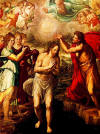100 Greatest Painters Artists Alphabetically Artists by Country Artists by Century Artists by Movement
Juan Fernandez Navarrete
called El Mudo, because he was deaf and mute
1526–1579
Education - received basic instruction from Fray Vicente de Santo Domingo, studied under Titian in Venice, Italy
Stylistically influenced by the following painters - Titian and Andrea del Sarto
Cause of Death - White Death also know as Tuberculosis
Mannerist painting style example - Baptism of Christ,
Biography
Juan Fernandez de Navarrete was born in the beautiful town of Navarre, Spain near the mountain range of the Pyrenees. He was called El Mudo (the mute) since childhood. He lost his hearing at the age of three and never learned to talk. Juan's amazing drawings skills became evident when he began communicating his needs by drawing them out with charcoal on paper.. The young artist never allowed his disabilities to hamper his dreams or ambitions and allowed his art to become his voice.
Like many Spanish painters he journeyed to Italy to soak up the rich traditions of painting and culture. Navarrete spent several years studying under Italian Master Titianin Venice. In 1568 he was selected to become the official court painter to monarch Philip II of Spain. Once in Spain the majority of his career was spent working on altarpieces for the Escorial.
The ungrateful king never valued the brilliance of Navarrete nor the great vision of Titian whom he had commissioned to paint a Last Supper. When the childish Monarch insisted on mutilating Titians great masterpiece by cutting it so it would fit into a church. Navarrete begged the king to allow him to paint a smaller version of Titians painting but Philip II was adamant and the masterpiece was cut and forever changed. According to historian and scholar, Clara Erskine Clement "When the “Last Supper” painted by Titian reached the Escorial, it was found to be too large for the space it was to occupy in the refectory. The king ordered it to be cut, which so distressed El Mudo that he offered to copy it in six months, in reduced size, and to forfeit his head if he did not fulfill his promise. He also added that he should hope to be knighted if he copied in six months what Titian had taken seven years to paint. But Philip was resolute, and the picture was cut, to the intense grief of the dumb Navarrete. While the painter lived Philip did not fully appreciate him; but after his death the king often declared that his Italian artists could not equal his mute Spaniard."
The paintings of Navarrete are rare. He was prolific but several were burned, lost or simply painted over by lesser artists. Navarrete major art-works were Nativity, Abraham and the Three Angels, and Baptism of Christ, 1568, now at the Museo del Prado in Madrid, Spain. He became known as the Spanish Titian and died in Toledo.
Masters of The Mannerist Style
Important Words, People, Phrases, Characteristics related to the Italian Renaissance Art Movement - rebirth, rediscovery of the classical world, City-state, Humanism, Humanist, Francesco Petrarch, Reform, The Prince, Theocracy, The Inquisition, Human Reasoning, Medici Academy, publication of Della Pittura, a book about the laws of mathematical perspective for artists, sfumato, chiaroscuro, linear perspective, Heliocentric Theory, Petrarch, Baldassare Castiglione, The Book of the Courtier, liberal arts, civic humanism, Verrocchio, secularism, Leonardo Bruni, Lorenzo Valla, Neo-Platonism, nominalism, Giotto, Masaccio, Botticelli, Quattrocento, vanishing point, Savonarola, oligarchy spiritually significant, illuminated manuscript, idealized biblical themes, scriptorium, emotion, illuminator, iconoclast, Michelangelo and Leonardo Da Vinci, Age of Discovery, axonometric drawing, curiosity about the natural world, mythology, realistic use of colours and light, Bonfire of the Vanities, Old Testament stories, ethereal and foggy backgrounds, Gospel parables, The Blackdeath, romanticized landscapes, Christian symbolism. Paradise
☼☼☼☼☼
If you feel you have worthwhile information you would like to contribute we would love to hear from you. We collect essential biographical information and artist quotes from folks all over the globe and appreciate your participation. When submitting please, if possible, site the source and provide English translation. Email to historyofpainter@gmail.com
© HistoryofPainters.com 2017
If you like this page and wish to share it, you are welcome to link to it, with our thanks.
Popular Questions About Renaissance Art History
What is the difference between Italian Renaissance art and Northern Renaissance art?
How did the Black Death impact European art history?
How did the Inquisition impact European art history?
What was the influence of the Medici Academy on Renaissance painters?
What was the Bonfire of the Vanities?
Who were the greatest painters of the Renaissance?
